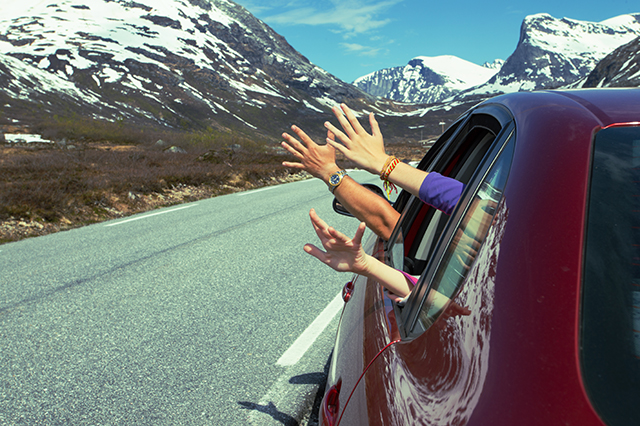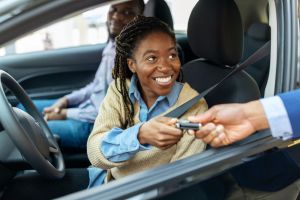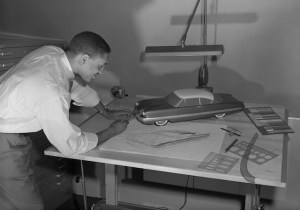During a long road trip with kids, your little passengers can become big distractions. Snacking, whining and arguing over whose turn it is with the iPad can make it next to impossible for mom or dad to focus on the road.
In this article, you will learn how to limit the real distractions that come with a road trip or weekend getaway with kids. We will also cover how to make the experience more fun for everyone involved.
A road trip with kids comes with distractions? No way.
There is more than a tinge of sarcasm in that question, but there are some real risks for the driver and occupants of a vehicle when kids enter the road trip equation.
While it seems like second nature to repeatedly glance in your rear-view mirror to check on a sleeping baby or to make sure the older kids have not turned the back seat into WrestleMania, it is always a gamble to take your eyes off the road, even for a matter of moments.
Some federal safety studies have concluded that interactions with passengers are more dangerous than cellphone use (even though talking on your phone or texting is still extremely dangerous with kids onboard or not).
Child passengers are also considered bigger distractions than adult passengers, according to safety experts. Child passengers are four times as distracting as adult passengers, and babies are eight times as distracting, according to research from the AAA Foundation for Traffic Safety.
What this boils down to is simple: Drivers need to focus on driving while driving. You can’t ignore your children, but there are certainly ways to limit the distractions during a road trip or weekend getaway with the kids.
Here’s some advice to keep your kids happy (and quiet) during your next driving vacation.

Set expectations.
Setting ground rules, like everybody uses the bathroom at the rest stop and everyone gets 30 minutes to play their music in the car, lets everyone know what’s expected of them. It will also help the dreaded “that’s not fair” from the peanut gallery. Reward good behavior and stick to your guns when rules are broken.
Bring the toys.
Let each child bring a couple of his or her favorite toys to keep busy. If they are a little older, try having them work on a travel journal. They can work together, with one writing and the other taking pictures, and then vice versa. “Keeping them occupied prevents typical sibling squabbling and antsy kids,” said Karen Blackburn, a Traffic Safety Specialist for AAA Northeast. Just make sure everything is at the feet of the adult riding shotgun, or where the kids can reach them without unbuckling or climbing into the back, which is incredibly dangerous. For those parents who enjoy a good podcast, I wrote about the Brains On! science podcast, which is interesting for both kids and adults. They recently did a summer series on cars, which can learn more about here.
Schedule plenty of stops.
Build frequent stops into your itinerary. AAA recommends stopping every two hours on a long trip. This could be a pit stop at a rest area or an hour at a park not far off your path. It gives your children something to look forward to and helps the driver remain alert when you get back on the road. You might even want to throw a ball around during your breaks to expend pent-up energy.
Keep them involved.
Let each child pick a stop along your route, at somewhere like a restaurant or a museum. This should keep them busy looking for cool places nearby with apps and maps.
Snack smart.
Dodge the dreaded “I’m hungry” or “I’m thirsty” by packing lots of drinks and snacks. Spill-proof cups are ideal for younger kids and foods like pretzels and granola bars are best to avoid the mess. String cheese is good, too, if you’re toting an insulated bag. Again, don’t go reaching for the food while the car is in motion. Keep it somewhere close or wait until your next stop to grab it.
Ready your ride.
A vehicle breakdown is not going to go over well. Before a road trip with kids – or any road trip for that matter – schedule a check up with your auto repair shop to make sure everything is good to go. Address any warning lights on your dashboard, check the condition of your oil and battery and inspect the tires for cracks, bulges and proper air pressure. You should also make sure there is adequate tread on the tires before you roll out. AAA strongly encourages drivers to keep emergency supplies in the trunk of their vehicles. A roadside emergency kit should include a flashlight, a blanket, a first aid kit and some basic tools. These could help you out of a jam or at least keep you comfortable until AAA arrives.
A vehicle break down is not going to over well with your children. Before a road trip with kids or with anybody for that matter, schedule a check up with your favorite auto repair shop to make sure everything is in good working order. Address any warning lights on your dashboard, and inspect the tires for cracks, bulging and air pressure. You should also make sure there is adequate tread left before you roll out. AAA strongly encourages drivers to pack emergency supplies in the trunk of their vehicles. A roadside emergency kit should include a flashlight, a blanket, a first aid kit and some basic tools. These could help you out of a jam or at least keep you comfortable until AAA arrives.
A road trip with kids is an awesome way to make memories. Do you have any tips for how to enjoy a road trip with your smallest passengers? Share them with us below!
Click here to learn more about automobile services from AAA.














